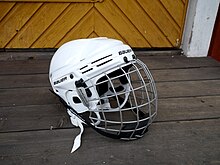Ice hockey equipment
As hockey equipment refers to those objects that a player during hockey games or in -line hockey has to wear. This is divided into work equipment that is necessary to be able to practice the sport at all and protective equipment that primarily protects the player from injury as a result of an accident . Modern protective clothing can also increase comfort by protecting against weather influences, such as cooling down or overheating in the sun.
The requirements for protective clothing are also laid down in various European and American standards, such as: B. EN ISO 10256: 2003 ("Head and face protection")
The equipment of the field player and the goalkeeper (goalie) differ. The club jersey is then worn over the entire equipment. Equipment must be worn correctly during the game, if not, the referee can issue a two-minute penalty for incorrect equipment .
background
When the actual ice hockey game developed, different clothing was sufficient to distinguish the teams. Only the goalkeeper wore shin guards that were borrowed from field hockey players. All players wore cloth or leather gloves , skates and hockey sticks country until 1880, the first specially made hockey stick was developed from wood. Since the rubber ball, later the puck , was played flat up until the 1920s , this equipment was sufficient.
In parallel with the further development of ice hockey, the equipment was also expanded and improved. Conversely, improvements in equipment changed the form of the game, for example new types of clubs and techniques made it possible not only to play the puck along the ice, but also to lift it.
Larger equipment manufacturers are Warrior , Bauer and CCM .
Player equipment
Outfield player
The equipment can be divided into two functions: In order for the sport to be practiced at all, the work equipment is required. This only includes the ice hockey stick and ice skates. All other components of the equipment belong to the protective equipment, which is supposed to protect the players from trauma. The equipment weighs around 5 to 8 kg.
The protective equipment is divided into two levels: the lower level is worn on the body and only the upper level is visible to the spectator.
The lower parts consist of the
- Sweat wash ,
- the groin guard , which protects the sexual organs or the girdle in the sense of protective underpants to protect the vital abdominal organs,
- the leg protection to be prepared for possible gang collisions
- the chest protector that covers the chest, shoulders and back
- the neck brace (only required in the junior area and in women's ice hockey). A narrow strip of foam protects the neck from blows and shots.
- the mouthguard , which not only protects teeth and jaw, but can also alleviate possible concussions from the collision of the upper and lower jaw. It is not mandatory to wear a face mask.
The visible parts of the equipment consist of:
- shirt
- Pants (also girdle) are padded and short. Long trousers could not prevail and are now only worn in inline hockey.
- Support
- Gloves and
- Helmet In Germany, male players over the age of 18 can decide for themselves whether they want to wear a helmet with half or full protection; a grid is required for women and players up to 18 years of age.
The team clothing (jersey, shorts, socks and helmet) must be designed accordingly.
goalkeeper
The ice hockey goalkeeper sometimes carries different equipment because he mainly gets the sharp shots on goal (up to 175 km / h).

Therefore, he wears in addition to normal protective equipment
- Leg guards which, seen from the lower leg, extend 8-10 cm above the knee,
- Breastplate, which in addition to the upper body also partially protects the arms,
- Goalkeeper mask
- Ruff and / or larynx protection (not mandatory),
- Catch glove,
- Stick glove,
- Goalie stick, also goalie trowel. The lower part of the shaft and the trowel are slightly wider, the stick is specially curved.
The total weight of goalkeeping equipment is around 20 kg.
Trivia
34,000 ice hockey gloves and chest guards that were lost from a shipload in the North Atlantic in 1999 were, according to the "friendly floatees", an important indicator for Curtis Ebbesmeyer in researching ocean currents.
Individual evidence
- ↑ Communication from the Commission in the context of the implementation of the Council Directive 89/686 / EEC on the approximation of the laws of the Member States relating to personal protective equipment (PDF)
- ↑ https://newsv1.orf.at/080217-21885/?href=https%3A%2F%2Fnewsv1.orf.at%2F080217-21885%2F21887txt_story.html
Web links
- Proper Safety Equipment for Ice Hockey
- Official IIHF rules (PDF; 741 kB), pp. 21–27, sections Player's Equipment and Goalkeeper Equipment


